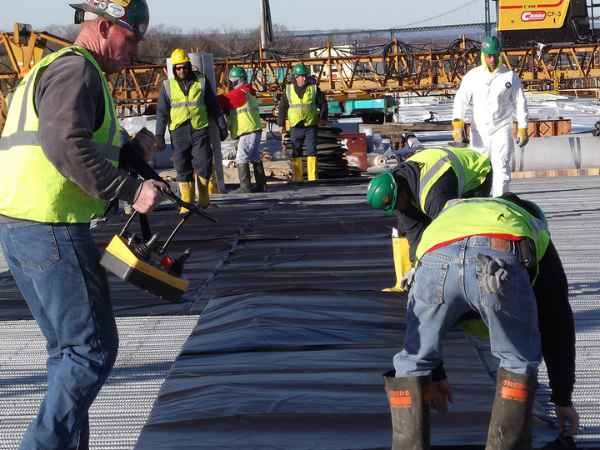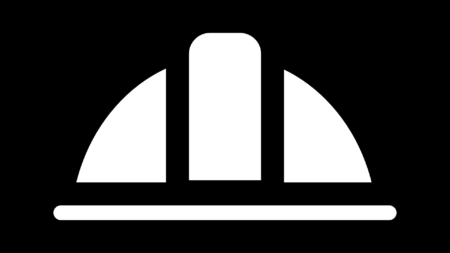One of the key aspects of optimal curing is temperature control. Several studies, such as this article, have shown a direct relationship between curing temperatures, short-term and long-term concrete strength, and other factors, such as air bubbles, which might lead to a porous and weaker structure.
Engineers have created different mechanisms to ensure proper curing within this context, ranging from chemical admixtures to physical dispositive, such as curing blankets.
These concrete curing blankets are special coverings that help control the environment around freshly poured concrete, regulate temperature, minimize moisture loss, and protect against external elements.
In this blog post, we will further investigate these blankets, exploring their concept, functionality, and benefits brought by their use.
What is a Curing Blanket?
Concrete curing blankets, also known as concrete insulation blankets or thermal curing blankets, are special covers that were initially created to keep temperatures under a desired range after pouring the fresh mix in icy weather conditions.
Some options, like Power Blank, even come with internal resistance to boost the heating process, quickly heat temperatures to 100º F (38º C).
Other options are usually made of durable materials like polyethylene or polypropylene and help control moisture levels (for hot weather conditions) and protect the fresh mix from other external elements during the curing process, like rain.
Do Concrete Curing Blankets Really Work?
Yes, curing blankets are highly effective in promoting optimal curing conditions, avoiding excessive cracking and shrinkage.
Further, they can also help to harness early strength in concrete, which might be required in elements like post-tensioned concrete, precast panels, or even tilt-up concrete.
A study undertaken by the Iowa Department of Transportation has shown that using curing blankets permitted concrete pavement reaching optimal opening strength (500 Psi) in 36 hours, representing almost a 50% time span decrease if compared to conventional curing (with an expected time of 60 hours).
When are the Benefits of Concrete Curing Blankets? (and When to Use them?)
These coverings will help you in different conditions:
- Cold Weather – curing blankets provide insulation, preventing freezing and maintaining the necessary temperature for effective curing.
- Hot Weather – curing blankets offer shade and insulation, protecting the concrete from excessive heat and preventing water loss (which might lead to excessive cracking and be detrimental to the hardening processes)
- Extended Curing Periods – the coverings help to create a controlled and uniform environment throughout the structure (i.e. slabs or pavement tranches).
The table below associates the benefits of curing blankets with temperature ranges and conditions.
Overall, they are widely used when building foundations, slabs, pavement, and sidewalks, which are highly exposed to temperature gradient variations.
|
Weather Condition |
Temperature Range |
Curing Issues |
Benefits of Curing Blankets |
|
Cold Weather |
Below 50°F (10°C) |
|
|
|
Hot Weather |
Above 90°F (32°C) |
|
|
|
Extended Curing Periods |
All |
|
|

What are the types of Concrete Curing Blankets?
Amongst various types, these are the most common:
- Polyethylene (PE) Curing Blankets
- Woven Polypropylene (PP) Curing Blankets
- Composite Curing Blankets
- Insulating Concrete Curing Blankets
- Reusable Curing Blankets
Further details about each category can be found below.
|
Type |
Description |
Mostly used when… |
|
Polyethylene (PE) Curing Blankets |
Lightweight with good insulation. Suitable for general-purpose concrete curing. |
General-purpose curing, moderate temperatures. |
|
Woven Polypropylene (PP) Curing Blankets |
Highly durable with superior insulation and moisture retention. Ideal for demanding environments. |
Heavy-duty projects, extreme temperatures or weather. |
|
Composite Curing Blankets |
Combine materials for enhanced properties. Provides insulation, moisture retention, and durability. |
Customized curing needs, varied temperature conditions. |
|
Insulating Concrete Curing Blankets (Thermal) |
Designed for superior thermal insulation. Offers precise temperature control. |
Cold weather, critical temperature control, prolonged curing. |
|
Reusable Curing Blankets |
Sustainable option for multiple uses. |
Recurring curing needs, long-term construction, sustainability focus. |
FAQ
How long do you leave curing blankets on concrete?
Curing blankets are typically left on concrete for 24 to 48 hours after pouring. However, consult specific curing guidelines provided by suppliers or industry standards for your project.
How to use Concrete Curing Blankets?
This 6-step offers a general guideline on how to use a concrete curing blanket:
- Step 1: Prepare the Concrete: Level and finish the concrete per standard procedures.
- Step 2: Place the Blankets: Immediately after pouring, place the curing blankets over the entire surface, ensuring complete coverage and overlapping the edges.
- Step 3: Secure in Place: Use weights or sandbags to secure the blankets and prevent shifting.
- Step 4: Monitor and Maintain: Regularly check the blankets for any damage or displacement, making necessary adjustments.
- Step 5: Follow Curing Timeframe: Consult guidelines for the recommended curing duration, typically 24 to 48 hours.
- Step 6: Remove the Blankets: Carefully remove the blankets after the curing period, avoiding any disruption.
Are Concrete Blankets Expensive?
The cost of concrete blankets varies based on type, size, features and quality.
You can find very cheap options, such as High-Density Polyethylene (HDPE) rolls (10′ x 100′) ]starting around $50, to advanced covers with precise temperature control, costing +$500.
What happens if concrete is not cured properly?
Improper curing of concrete can have significant consequences on its strength, durability, and overall quality. Here are some potential issues that may arise:
- Reduced Strength: Inadequate curing weakens the concrete, making it prone to cracking, instability, and lower load-bearing capacity.
- Increased Permeability: Improperly cured concrete becomes more permeable, allowing water, chemicals, and other substances to penetrate the surface and cause reinforcement corrosion, deterioration, and, ultimately, structural damage.
- Cracking and Surface Defects: Insufficient curing can result in the formation of cracks, compromising the aesthetics, functionality, and long-term durability of the concrete.
- Compromised Durability: Proper curing contributes to the long-term durability of concrete. Without adequate curing, the concrete may experience premature wear, reduced resistance to environmental factors, shortened lifespan, and significant maintenance costs.

How to Ensure proper curing of concrete?
Apart from using curing blankets, you should also consider the following measures:
- Maintain consistent moisture levels by periodically dampening the concrete surface or using curing compounds.
- Control temperature variations, especially in extreme weather conditions (both cold and hot)
- Protect the concrete from direct sunlight and drying winds.
- Use windbreaks or shade to minimize evaporation.
- Avoid traffic or other forms of stress on the concrete during the initial curing period.
- Consider the use of admixtures, such as hydration stabilizers or set retarders, to extend the curing time and enhance moisture retention.
Conclusion
In conclusion, concrete curing blankets can significantly help the curing and hardening processes.
Among their benefits, curing blankets are crucial in maintaining the ideal temperature range for successful curing, which may help to prevent cracking, harness early strength, and ensure consistent curing conditions across large structures, such as slabs or pavements.
Improper curing might lead to reduced structural capacity, cracking, water infiltration, unlevel surfaces, and, ultimately, poor-quality structures and increased maintenance costs.
With several options available in the market, you can find the most common options, such as Polyethylene (PE), in any construction store close to you and easily lay them down over freshly poured concrete.

















